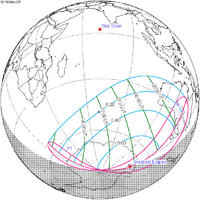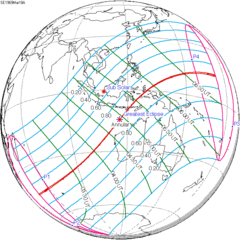| Total eclipse | |||||||||||||||||
 The Moon's hourly motion shown right to left The Moon's hourly motion shown right to left | |||||||||||||||||
| Date | March 13, 1960 | ||||||||||||||||
|---|---|---|---|---|---|---|---|---|---|---|---|---|---|---|---|---|---|
| Gamma | −0.1799 | ||||||||||||||||
| Magnitude | 1.5145 | ||||||||||||||||
| Saros cycle | 122 (53 of 75) | ||||||||||||||||
| Totality | 93 minutes, 59 seconds | ||||||||||||||||
| Partiality | 219 minutes, 23 seconds | ||||||||||||||||
| Penumbral | 344 minutes, 47 seconds | ||||||||||||||||
| |||||||||||||||||
| ← September 1959September 1960 → | |||||||||||||||||
A total lunar eclipse occurred at the Moon’s ascending node of orbit on Sunday, March 13, 1960, with an umbral magnitude of 1.5145. A lunar eclipse occurs when the Moon moves into the Earth's shadow, causing the Moon to be darkened. A total lunar eclipse occurs when the Moon's near side entirely passes into the Earth's umbral shadow. Unlike a solar eclipse, which can only be viewed from a relatively small area of the world, a lunar eclipse may be viewed from anywhere on the night side of Earth. A total lunar eclipse can last up to nearly two hours, while a total solar eclipse lasts only a few minutes at any given place, because the Moon's shadow is smaller. Occurring about 5.9 days before perigee (on March 19, 1960, at 7:10 UTC), the Moon's apparent diameter was larger.
This eclipse afforded astrophysicist Richard W. Shorthill the opportunity to make the first infrared pyrometric temperature scans of the lunar surface, and led to his discovery of the first lunar "hot spot" observed from Earth. Shorthill found that the temperature of the floor of the Tycho crater was 216° Kelvin (—57°C), significantly higher than the 160K (—113°C) in the area around the crater.
Visibility
The eclipse was completely visible over North America and the central and eastern Pacific Ocean, seen rising over east and northeast Asia and Australia and setting over South America, western Europe, and west Africa.
 
|
Eclipse details
Shown below is a table displaying details about this particular solar eclipse. It describes various parameters pertaining to this eclipse.
| Parameter | Value |
|---|---|
| Penumbral Magnitude | 2.54151 |
| Umbral Magnitude | 1.51449 |
| Gamma | −0.17990 |
| Sun Right Ascension | 23h33m28.3s |
| Sun Declination | -02°52'01.0" |
| Sun Semi-Diameter | 16'05.3" |
| Sun Equatorial Horizontal Parallax | 08.8" |
| Moon Right Ascension | 11h33m15.8s |
| Moon Declination | +02°42'09.5" |
| Moon Semi-Diameter | 15'39.9" |
| Moon Equatorial Horizontal Parallax | 0°57'29.4" |
| ΔT | 33.3 s |
Eclipse season
See also: Eclipse cycleThis eclipse is part of an eclipse season, a period, roughly every six months, when eclipses occur. Only two (or occasionally three) eclipse seasons occur each year, and each season lasts about 35 days and repeats just short of six months (173 days) later; thus two full eclipse seasons always occur each year. Either two or three eclipses happen each eclipse season. In the sequence below, each eclipse is separated by a fortnight.
| March 13 Ascending node (full moon) |
March 27 Descending node (new moon) |
|---|---|
 |

|
| Total lunar eclipse Lunar Saros 122 |
Partial solar eclipse Solar Saros 148 |
Related eclipses
Eclipses in 1960
- A total lunar eclipse on March 13.
- A partial solar eclipse on March 27.
- A total lunar eclipse on September 5.
- A partial solar eclipse on September 20.
Metonic
- Preceded by: Lunar eclipse of May 24, 1956
- Followed by: Lunar eclipse of December 30, 1963
Tzolkinex
- Preceded by: Lunar eclipse of January 29, 1953
- Followed by: Lunar eclipse of April 24, 1967
Half-Saros
- Preceded by: Solar eclipse of March 7, 1951
- Followed by: Solar eclipse of March 18, 1969
Tritos
- Preceded by: Lunar eclipse of April 13, 1949
- Followed by: Lunar eclipse of February 10, 1971
Lunar Saros 122
- Preceded by: Lunar eclipse of March 3, 1942
- Followed by: Lunar eclipse of March 24, 1978
Inex
- Preceded by: Lunar eclipse of April 2, 1931
- Followed by: Lunar eclipse of February 20, 1989
Triad
- Preceded by: Lunar eclipse of May 12, 1873
- Followed by: Lunar eclipse of January 12, 2047
Lunar eclipses of 1958–1962
| Ascending node | Descending node | |||||||
|---|---|---|---|---|---|---|---|---|
| Saros | Date Viewing |
Type Chart |
Gamma | Saros | Date Viewing |
Type Chart |
Gamma | |
| 102 | 1958 Apr 04
|
Penumbral
|
-1.53805 | |||||
| 112 | 1959 Mar 24
|
Partial
|
-0.87571 | 117 | 1959 Sep 17
|
Penumbral
|
1.02963 | |
| 122 | 1960 Mar 13
|
Total
|
-0.17990 | 127 | 1960 Sep 05
|
Total
|
0.24219 | |
| 132 | 1961 Mar 02
|
Partial
|
0.55406 | 137 | 1961 Aug 26
|
Partial
|
-0.48947 | |
| 142 | 1962 Feb 19
|
Penumbral
|
1.25115 | 147 | 1962 Aug 15
|
Penumbral
|
-1.22104 | |
| Last set | 1958 May 03 | Last set | 1958 Oct 27 | |||||
| Next set | 1963 Jan 09 | Next set | 1962 Jul 17 | |||||
Saros 122
It was part of Saros series 122.
Half-Saros cycle
A lunar eclipse will be preceded and followed by solar eclipses by 9 years and 5.5 days (a half saros). This lunar eclipse is related to two total solar eclipses of Solar Saros 129.
| March 7, 1951 | March 18, 1969 |
|---|---|

|

|
See also
Notes
- "March 12–13, 1960 Total Lunar Eclipse (Blood Moon)". timeanddate. Retrieved 29 December 2024.
- "Moon Distances for London, United Kingdom, England". timeanddate. Retrieved 29 December 2024.
- F. Link, Eclipse Phenomena in Astronomy (Springer, 2012) p119
- "Total Lunar Eclipse of 1960 Mar 13" (PDF). NASA. Retrieved 29 December 2024.
- "Total Lunar Eclipse of 1960 Mar 13". EclipseWise.com. Retrieved 29 December 2024.
- Mathematical Astronomy Morsels, Jean Meeus, p.110, Chapter 18, The half-saros
External links
- 1960 Mar 13 chart Eclipse Predictions by Fred Espenak, NASA/GSFC
This lunar eclipse-related article is a stub. You can help Misplaced Pages by expanding it. |


